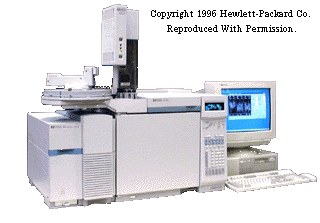|
Bureau of Forensic Services
An Introduction To Gas Chromatography / Mass Spectrometry (GC/MS)
 In the simplest terms the GC/MS instrument represents a device that separates chemical mixtures (the GC component) and a very sensitive detector (the MS component) with a data collector(the computer component).
In the simplest terms the GC/MS instrument represents a device that separates chemical mixtures (the GC component) and a very sensitive detector (the MS component) with a data collector(the computer component).
Once the sample solution is introduced into the GC inlet it is vaporized immediately because of the high temperature (250 degrees C) and swept onto the column by the carrier gas (usually Helium).
The sample flows through the column experiencing the normal separation processes. As the various sample components emerge from the column opening, they flow into the capillary column interface. This device is the connection between the GC column and the MS. Some interfaces are separators and concentrate the sample via removal of the helium carrier.
The sample then enters the ionization chamber. Two potential methods exist for ion production. The most frequently used method in the Toxicology lab is electron impact (EI). The occasionally used alternative is chemical ionization (CI). For electron impact ionization a collimated beam of electrons impact the sample molecules causing the loss of an electron from the molecule. A molecule with one electron missing is represented by M+ and is called the molecular ion (or parent ion). When the resulting peak from this ion is seen in a mass spectrum, it gives the molecular weight of the compound. Chemical ionization begins with ionization of methane (or other gas), creating a radical which in turn will impact the sample molecule to produce M.H+ molecular ions. Some of the molecular ions fragment into smaller daughter ions and neutral fragments. Both positive and negative ions are formed but only positively charged species will be detected.
Less fragmentation occurs with CI than with EI, hence CI yields less information about the detailed structure of a molecule, but does yield the molecular ion; sometimes the molecular ion can not be detected by the EI method, hence the two methods complement one another. Once ionized, a small positive potential is used to repel the positive ions out of the ionization chamber.
The next component is a mass analyzer (filter), which separates the positively charged
particles according to their mass. Several types of separating techniques exist; quadrupole filters, ion traps, magnetic deflection, time-of-flight, radio frequency,
cyclotron resonance and focusing to name a few. The most common are quadrupoles and ion traps.
After the ions are separated according to their masses, they enter a detector and then on to an amplifier to boost the signal.
The detector sends information to the computer which acts as a "clearing house". It records all the data produced, converts the electrical impulses into visual displays and hard copy displays. The computer also drives the mass spectrometer.
Identification of a compound based on it's mass spectrum relies on the fact that every
compound has a unique fragmentation pattern. Even isomers can be differentiated by the
experienced operator. Generally, more information is generated than could possibly be
used. A library of known mass spectra which may be several thousand compounds in
size is stored on the computer and may be searched using computer algorithms to assist the analyst in identifying the unknown. It is important to incorporate all other available structural information (chemical, spectral, sample history) into the interpretation wherever appropriate.
The ultimate goal is accurate identification of a compound, which can be facilitated bythe utilization of the GC/MS.
Return to the Toxicology Homepage
|

